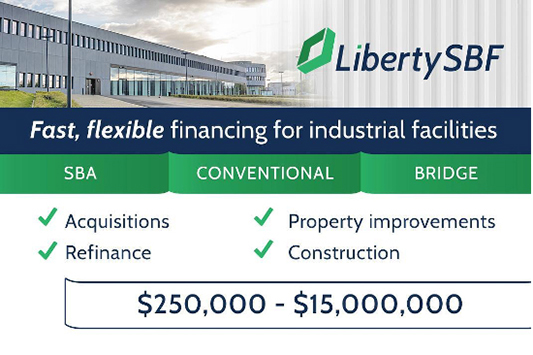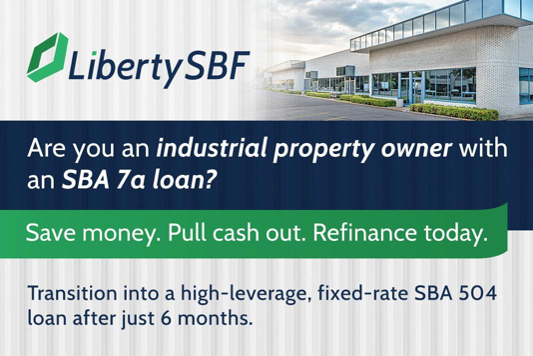Learn more about high leverage, low-cost financing for industrial property construction, acquisition and refinance opportunities in 2022.

By Alexander Cohen, CEO of Liberty SBF
In general, commercial real estate is one of the areas that has bounced back rather well since the initial effects of COVID-19. Breaking it down further, companies that operate in the manufacturing, industrial, or logistics industries have seen real estate values soar.
This is a big change from 10 to 15 years ago, when industrial property values weren’t nearly as strong. Now, the effects from the pandemic have actually accelerated the radical shift from in-store retail to e-commerce logistics, thus driving up the price of warehouse- and logistics-focused properties, in particular. This trend should continue into 2022 and beyond because the supply is low and demand is high. We’ve seen development of warehouse, industrial, and logistics spaces increase in the last three years, which will likely continue as well.
What does this mean for your company? Here are some ways you may be able to capitalize on industrial trends heading into next year.

Many eyes are on the Federal Reserve, as it announced in early November its anticipated decision to begin tapering bond purchases. Typically, inflationary pressures result in declining asset values, but in this case, the supply-demand imbalance may not bring that to fruition. Even as supply chain issues cripple some businesses, expect warehouse, manufacturing, and logistics property values to remain high.
We are at an inflection point with interest rates, which makes it a great time to refinance if you own one of these property types. This is especially true if your initial loan was through the Small Business Administration (SBA), which recently implemented an interim rule to incentivize refinancing its 7a loans to 504 loans.
This is akin to the push to refinance residential mortgages with historical low rates. Those low rates extend to commercial real estate and there’s an opportunity to pull cash out of up to 20% of the property’s value, plus lower monthly payments. It’s a no-brainer. We estimate there’s nearly $200 billion in outstanding 7a loans in this asset class that could qualify for the SBA refinance.
Owners are seeing greater appreciation on their properties. If you’re looking to buy, it can be hard to make the numbers work. Since the height of the pandemic, warehouse, logistics, and multifamily residential housing properties have overperformed while hotels, retail, and big office space have largely underperformed from a value standpoint.
The average cost per square foot for an industrial asset can be over $300 in a prime market like San Francisco. That’s not to say it’s impossible to make a good investment in this space.
The government has used the SBA as the preferred vehicle for subsidies available to borrowers. The SBA has continued to make its loans attractive by cutting fees and loosening some of the qualification standards previously in place, while providing the highest leverage and lowest cost that a borrower can obtain. We expect to see those benefits continuing for the next couple of years, making it a great financing tool for borrowers looking to build industrial and warehouse properties.
Considering the rising costs of goods and services, particularly building materials, SBA loans are making acquisitions and construction projects more feasible to pull off. There are other subsidies, like the SBA 504 Green Loan program, which can be applied to these property types and environmental, social, and governance (ESG) initiatives are seen as a great way to increase portfolio value.
If you are looking to build new construction, you’ll want to consider throughput and the flow of inventory when reviewing blueprints, because these factors affect the efficiency of your operations. Industrial spaces have largely gone unchanged for decades and new business demands are changing the specs that developers are looking to implement in new construction.
For instance, it may be obvious that you need the right ceiling height to accommodate both inventory and machinery, but other considerations are the number of truck bays and how ingress and egress factor into the layout of the building. Proximity to rail spur may also influence where you want to build this new construction.
Borrowers looking to take advantage of the market need to differentiate themselves to get funding. Lenders underwrite not just the company or the property, but also the owners themselves. Being able to conform to credit parameters will make a borrower more attractive to lenders.
Manufacturing, industrial, and logistics properties should see value remain high for at least the next two years. Motivated and qualified borrowers still have time to get on board as the industry remains strong and demand doesn’t appear to be dipping anytime soon.

Alexander Cohen is CEO of Liberty SBF, an experienced commercial real estate finance company. With a special expertise in small-balance commercial lending, Liberty SBF positions to address the needs of small businesses facing a challenging credit environment.
In this episode, I sat down with Beejan Giga, Director | Partner and Caleb Emerson, Senior Results Manager at Carpedia International. We discussed the insights behind their recent Industry Today article, “Thinking Three Moves Ahead” and together we explored how manufacturers can plan more strategically, align with their suppliers, and build the operational discipline needed to support intentional, sustainable growth. It was a conversation packed with practical perspectives on navigating a fast-changing industry landscape.